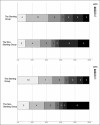Stenting Versus Non-stenting Strategy in Endovascular Treatment of Acute Anterior Ischemic Stroke Patients with Tandem Occlusion
- PMID: 40207940
- PMCID: PMC12049226
- DOI: 10.4103/aian.aian_828_24
Stenting Versus Non-stenting Strategy in Endovascular Treatment of Acute Anterior Ischemic Stroke Patients with Tandem Occlusion
Abstract
Background and objectives: The optimal endovascular treatment (EVT) strategy for acute tandem occlusion patients has not been decided yet, and a knowledge gap still exists in the literature. Therefore, we aimed to compare the two different interventional strategies, stenting and non-stenting, for the treatment of acute tandem occlusion patients.
Methods: This was a single-center, retrospective, observational cohort study, which was conducted in a tertiary referral center. We reviewed all acute stroke patients between January 2016 and January 2024. We assessed the effects of the two strategies, stenting and non-stenting, on seven outcome measures, namely: hemorrhagic transformation after EVT, number of days in the neurology intensive care unit (N-ICU), number of days in the hospital, in-hospital mortality, functional outcome at discharge, 3-month functional outcome, and 3-month mortality.
Results: We included 54 acute tandem occlusion patients who were treated with EVT in the study. Thirty-five (64.8%) patients underwent emergency carotid stenting during EVT and 19 patients (35.2%) did not receive emergency carotid stenting. Hemorrhagic transformation after EVT, number of days in N-ICU, number of days in the hospital, in-hospital mortality, functional outcome at discharge, and 3-month functional outcome did not differ between the two groups ( P > 0.05). Emergency stenting during EVT significantly reduced the probability of 3-month mortality (odds ratio = 0.21, confidence interval: 0.04 to 0.96, P = 0.04).
Conclusions: This study showed that emergency stenting in the acute tandem occlusion patients decreased the probability of mortality. Further research is needed on this.
Keywords: Stroke; carotid artery diseases; endovascular therapy; stents.
Copyright © 2025 Annals of Indian Academy of Neurology.
Conflict of interest statement
There are no conflicts of interest.
Figures
References
-
- Rubiera M, Ribo M, Delgado-Mederos R, Santamarina E, Delgado P, Montaner J, et al. Tandem internal carotid artery/middle cerebral artery occlusion: An independent predictor of poor outcome after systemic thrombolysis. Stroke. 2006;37:2301–5. - PubMed
-
- Goyal M, Menon BK, van Zwam WH, Dippel DWJ, Mitchell PJ, Demchuk AM, et al. Endovascular thrombectomy after large-vessel ischaemic stroke: A meta-analysis of individual patient data from five randomised trials. Lancet. 2016;387:1723–31. - PubMed
-
- Jacquin G, Poppe AY, Labrie M, Daneault N, Deschaintre Y, Gioia LC, et al. Lack of consensus among stroke experts on the optimal management of patients with acute tandem occlusion. Stroke. 2019;50:1254–6. - PubMed
-
- Rahme R, Abruzzo TA, Ringer AJ. Acute ischemic stroke in the setting of cervical carotid occlusion: A proposed management strategy. World Neurosurg. 2011;76:60–5. - PubMed
-
- Veunac L, Saliou G, Knebel JF, Bartolini B, Puccinelli F, Michel P, et al. Revascularization of carotid artery occlusion using stenting versus non stenting in endovascular management of tandem occlusion stroke. J Clin Neurosci. 2022;98:15–20. - PubMed
LinkOut - more resources
Full Text Sources
Miscellaneous


